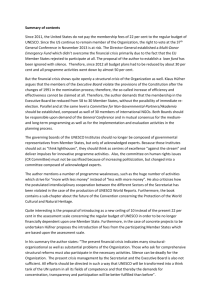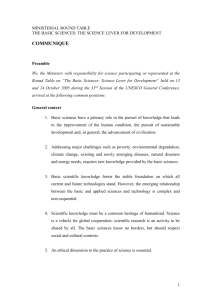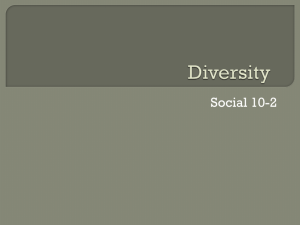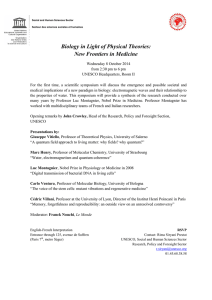Key performance indicators for Education
advertisement
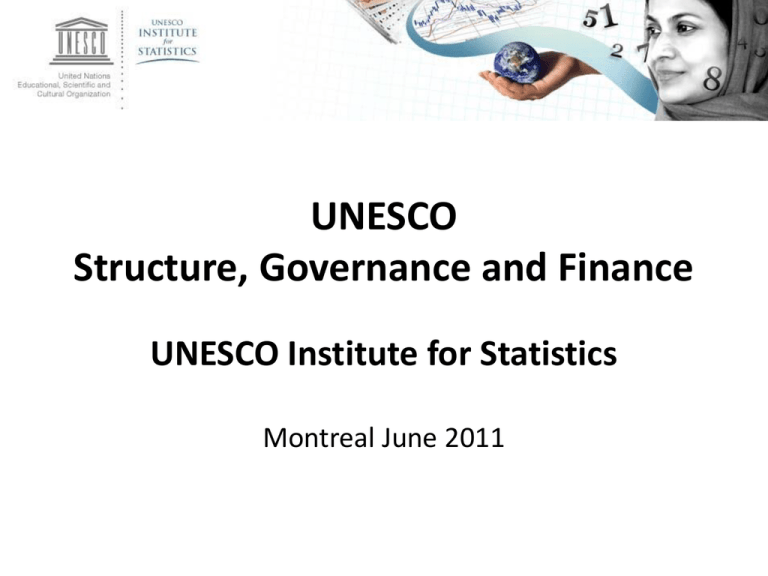
UNESCO Structure, Governance and Finance UNESCO Institute for Statistics Montreal June 2011 Andrew Barton • Statistical Assistant: Data Processing & Standards – Regional Responsibility: Anglophone Africa • Education: – MSc. Economics from the University of Amsterdam – BComm. Economics from John Molson School of Business • Previous work experience: – Advisor in Statistics: Leaseurope/Eurofinas (European finance and leasing industry - NPO) – Junior Demographic Analyst: Department of Foreign Affairs and International Trade Canada – Policy Analyst: Catholic Community Services (NPO in Montreal) Shereen Joseph • Worked in the communications unit in various capacities at the UIS: – Communications – Publications • Over 10 years experience in the field • Education: – MSc. Journalism at Concordia University (ongoing) – BSc. Microbiology from the University of Alberta • Freelance Consultant Presentation Outline • • • • Overview: History, Mission & Priorities UNESCO Structure & Governance Financing Differences between IGO and NPO Overview: History • 1942: Conference of Allied Ministers of Education - CAME – European countries looking to reconstruct their systems of education in the post war era • 1945: A proposal from CAME was made at a United Nations Conference for the establishment of an educational and cultural organization (London) • At the end of the conference, thirty-seven countries founded the United Nations Educational, Scientific and Cultural Organization (16 November) Overview: History Preamble of the Constitution “That since wars begin in the minds of men, it is in the minds of men that the defences of peace must be constructed; Overview: Mission & Priorities • UNESCO’s mission is to contribute to the building of peace, the eradication of poverty, sustainable development and intercultural dialogue through education, the sciences, culture, communication and information. • UNESCO focuses on two global priorities: – Africa & Gender Equality Overview: Mission & Priorities • The broad goals and objectives of the international community – as set out in the internationally agreed development goals (Millennium Development Goals and Education for All) – underpin all UNESCO’s strategies and activities. Overview: Mission & Priorities • In fulfilling its mission, UNESCO will carry out for the international community five established functions: i. ii. iii. iv. v. laboratory of ideas, including foresight standard-setter clearing house capacity-builder in Member States in UNESCO’s fields of competence catalyst for international cooperation UNESCO Structure and Governance • UNESCO is a specialized agency of the UN (carries out prescribed mandate, but independent) • UNESCO is an Intergovernmental Organization - IGO – Goals and scope are outlined in a treaty or charter – Membership is limited to nation states / countries • Three levels of membership (193 members, 7 associate members & 2 observers) – Members are required to make yearly contributions UNESCO Structure and Governance • Governing Bodies – General Conference – Executive Board • Secretariat UNESCO Structure and Governance • General Conference – Primary decision making body of UNESCO – Meets once every 2 years to determine the policies and main lines of work of the organization – 1 country – 1 vote – Approves UNESCO’s biennial programmes and budget – Every 4 years, it appoints the Director General UNESCO Structure and Governance • Executive Board – Composed of 58 member states who are elected at the General Conference every two years – Choice of representatives depends on diversity of cultures and geographic regions – Responsible for the execution of the programme adopted at the General Conference – Meets twice a year to examine the Organization’s programme and budget UNESCO Structure and Governance • Secretariat – The Director General is the executive head of UNESCO – DG formulates proposals for appropriate action by the General Conference and Executive Board – DG prepares a draft biennial programme and budget – Staff implements the approved programme – Organizational Chart • Central Services • Programme Sectors • Support Sectors • Field Offices UNESCO Financing Sources • Total Budget: $1,115,751,400 USD • Membership contributions (assessment) – Represents 58% of the 2010-2011 budget – For 2010-2011: $653,000,000 USD • Extra budgetary funding (voluntary) – UNESCO becoming more reliant on extra budgetary funds – Represents 42% of the 2010-2011 budget – For 2010-2011: $462,751,400 USD UNESCO Financing Sources • Five major sources of extra budgetary funding: – Bilateral Government Donors – The United Nations Funds and Programmes – Multilateral Development Banks (WBG) – The European Commission – The Private Sector UNESCO Financing Protocol • Biennial budget is submitted by the Director General as a resolution at the UNESCO General Conference for approval • Scale of Assessment – Set at the United Nations General Conference on a yearly basis • Assessment is based on a countries Gross National Income and a country’s capacity to pay • Contributions are to be paid partly in US dollars and partly in Euros (can pay in national currency) Members Contribution % USA 22.000% Japan 12.530% Germany 8.018% UK 6.604% France 6.123% Italy 4.999% Canada 3.207% China 3.189% Spain 3.177% Mexico 2.356% Others 27.797% IGO vs NPO • Similarities: – Both are not driven by profit – Funding sources are the same (public and private) • Differences: – NPO can represent both public and private interests – IGO represent public interests – Governance & Structure • NPO structure depends on the type of organization • IGOs structure based on a charter or treaty between countries – Financing structure is different (i.e. UN scale assessment) List of IGO’s in Montreal • • • • UNESCO Institute for Statistics ICAO – International Civil Aviation Organization Secretariat on the Convention of Biodiversity Multilateral Fund for the Implementation of the Montreal Protocol • Commission for Environmental Cooperation (Canada, Mexico & US only) • Cospas Sarsat (Canada, France, Russia, & US only)


